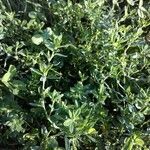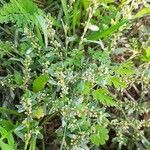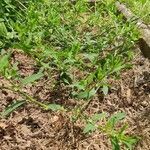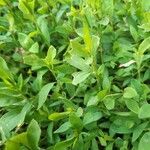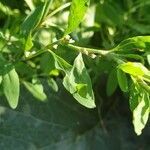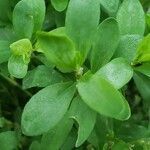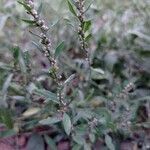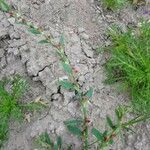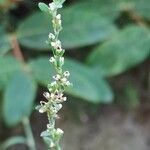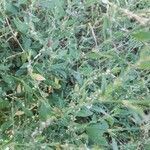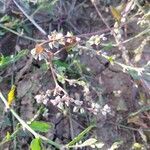Glabrous annual, sometimes biennial, mostly prostrate or decumbent, sometimes spreading; stems numerous, slender, wiry, to c. 1 m long, often forming large, flat mats to c. 1.5 m diam.; taproot fairly stout. Lvs of young and main stems often twice as large as those of branches, subsessile or with petiole to 1 cm long. Lamina (3)-10-40 × (0.5)-3-15 mm, lanceolate to elliptic or ovate, rarely obovate or linear, green or glaucescent, sometimes purplish, entire; base cuneate or rounded; apex acute or subacute; branch lvs sometimes < 5 mm long. Ochreae initially 2-5 mm long, longer in young plants, silvery-hyaline, ± acute, becoming brown, soon lacerate, often enclosing petiole. Fls 1-6 in fascicles in the axils of lvs, extending almost to stem bases; pedicels enclosed by ochreae. Perianth 2-3 mm long at anthesis, usually united for 1/4-⅓ length; segments strongly imbricate, rarely only slightly imbricate, ± oblong, glabrous; margins and apex white, pale pink, or rose, often variously coloured on the same plant, accrescent. Nut 2-3 mm long, ovoid to almost biconvex, dark reddish brown, ± shining, finely striate or granular, regularly trigonous or sometimes 1 side wider or narrower than others, enclosed in perianth or with apex protruding.
Herbs annual. Stems prostrate, ascending, or erect, 10-40 cm tall, much branched from base. Petiole short or nearly absent, articulate at base; leaf blade lanceolate or narrowly elliptic, 1-4 cm × 3-12 mm, both surfaces glabrous, midvein and lateral veins conspicuous, base cuneate, margin entire, apex acute or nearly obtuse; ocrea: lower part brown, upper part white or throughout brown, membranous, veined, apex lacerate. Flowers 1-5; axillary; bracts thinly membranous. Pedicel slender, articulate at apex. Perianth green, margin white or pinkish, 5-cleft to 2/3-3/4; tepals elliptic, 2-2.5 mm. Stamens 8; filaments dilated at base. Styles 3, free, short; stigmas capitate. Achenes included or slightly exceeding persistent perianth, black-brown, opaque, ovoid, trigonous, 2.5-3 mm, minutely granular striate. Fl. May-Jul, fr. Jul-Aug. 2n = 40, 60.
Decumbent, annual herb, 0.15-1.00 m high; much branched, internodes of main stems > 15 mm long. Ocreae basally brownish red, lacerated margins silvery, hyaline. Leaves scattered or close together, linear-oblong to narrowly elliptic, up to 50 x 18 mm, base cuneate, apex acute, margins sometimes revolute, surfaces punctate glandular. Bracts silvery hyaline. Flowers fascicled in axils of leaves, 1-5 flowers per bract. Perianth pink, white or greenish. Stamens 7 or 8, included. Flowering time Oct.-Apr. Fruit a dark brown to black nut, matt.
Freely branched, sprawling to suberect, heterophyllous annual, to 1 or reputedly 2 dm; early lvs lanceolate or lance-ovate, 2.5–6 cm × 4–15 mm, the later ones only a third as large; ocreae 4–8 mm, hyaline, becoming lacerate; mature perianth 2.5–4 mm, divided to well below the middle, its segments subequal, with white to pink margins and flat tip; achenes 2.2–3.2 mm, dark brown, striate-papillose, included or barely exserted; 2n=40, 60. Cosmopolitan weed of cult. fields and waste places.
A small herb which lays along the ground. It has a long and slender but very fibrous taproot. There are many branches coming from this taproot. The branches can be upright but often lie along the ground. They can be 90-120 cm long. On young plants the lower leaves are much larger than the stem leaves. The leaves are narrow and sword shaped. The leaves are blue-green. There can be 5 flowers in the axil of a leaf. The flowers are white.
Annual herb; mat-forming. Stems decumbent to procumbent, up to 1 m long. Leaves subsessile; blade narrowly ovate or elliptic, 10-40 x 4-8 mm, those subtending flowering clusters 2-3 x smaller than those on vegetative shoots. Ocrea silvery hyaline, 5-8 mm long, lacerate, with brownish veins. Flowers: in sessile or subsessile, axillary fascicles; perianth pink, white or greenish; Oct.-Apr. Fruit dull brown, 2.5-3.5 x 1.0-1.5 mm.
Sprawling to prostrate annual, up to 1 m long, with striate stems. Leaves linear to narrowly elliptic, margin sometimes revolute, sheathing stipules silvery, papery, lacerate. Flowers (1-)3-5 in axils, 5-merous, pink, white or greenish. Fruit shorter than perianth.
Sprawling to prostrate annual to 30 cm, with striate stems. Leaves elliptic-oblanceolate, stipules papery, lacerate. Flowers 3-5 in axils, 5-merous, pink. Fruits shorter than perianth.
Decumbent to prostrate herb. Internodes of main stem longer than 15 mm, if shorter then leaves always wider than 4 mm. Nut trigonous, matt. Flowers pink, white or greenish.
